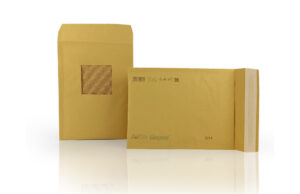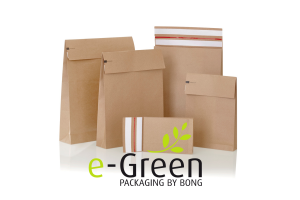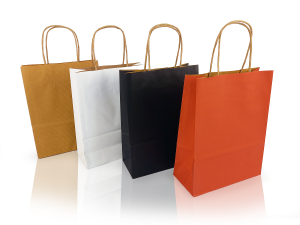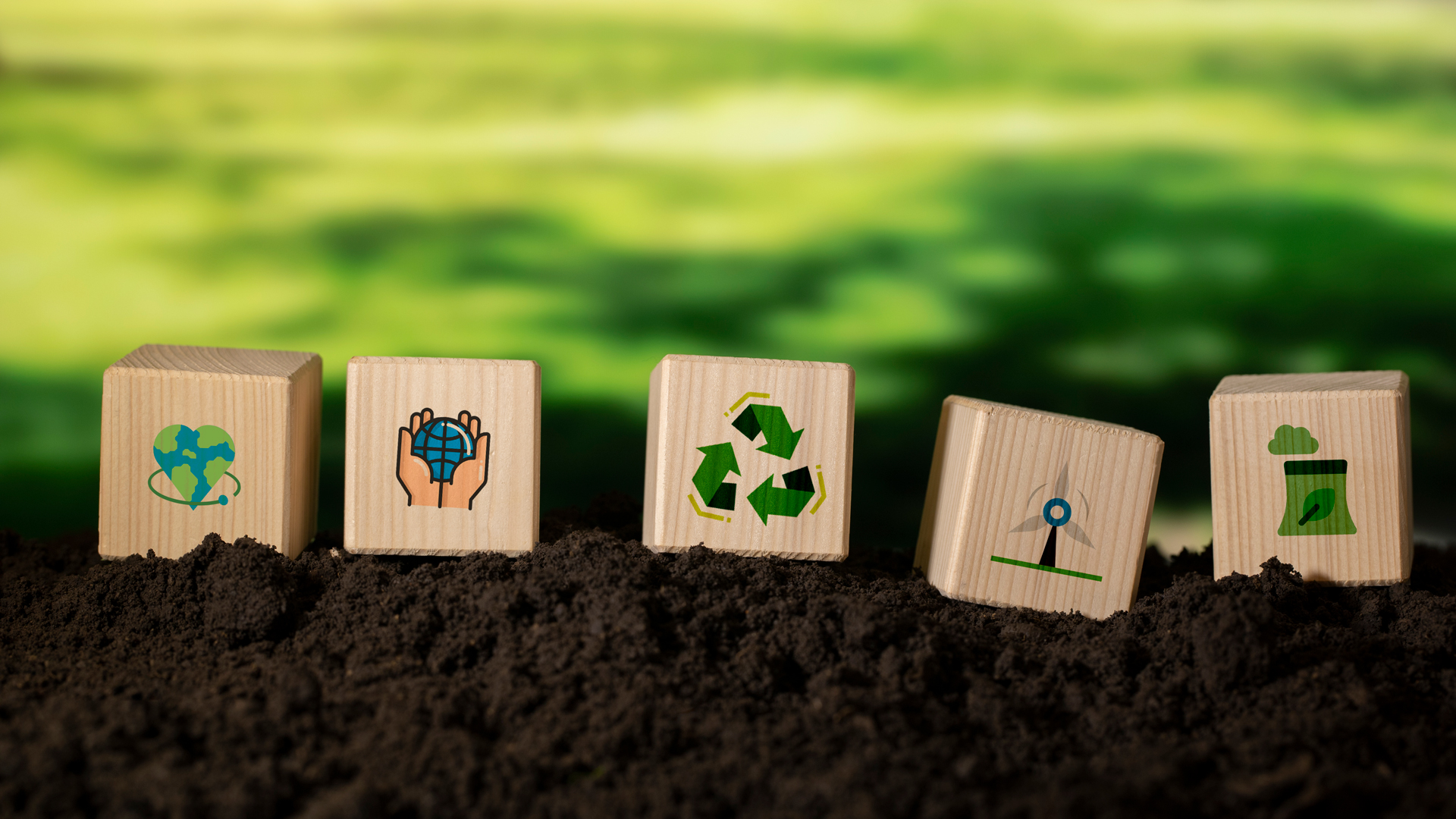
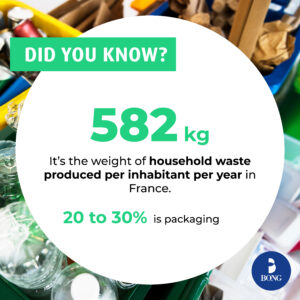
Do you feel like your bins are filling up too quickly? Once the thorny debate of “Who’s going to take out the trash tonight?” is settled, let’s move on to a number (or two). 582 kg is the weight of household waste produced per inhabitant per year in France, according to a report by the Cour des Comptes (French Court of Auditors) in 2023. Of this 582 kg, 20 to 30% is packaging.
In response to the challenges caused by the overproduction of waste, particularly plastic waste, and the need to promote a more circular economy, the French government enacted the AGEC law (Anti-Waste for a Circular Economy Act) on January 30, 2020.
Today, we take a look at this significant law, its objectives, and its implications for e-commerce and retail packaging brands and manufacturers.
Table of contents
The AGEC law: from a linear economy to a circular economy
Say goodbye to “produce, consume, dispose”! The AGEC law aims to transform the linear economy into a circular economy and to rethink our modes of production, consumption, and waste management.
Before going further, let’s talk about the concept of circular economy.
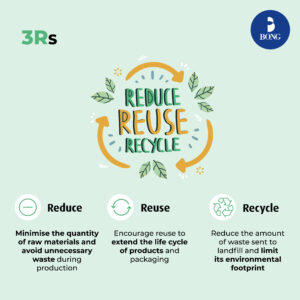
“The circular economy involves producing goods and services sustainably by limiting the consumption and waste of resources and the production of waste. It is about moving from a disposable society to a more circular economic model.” – Definition by the Ministry of Ecological Transition and Territorial Cohesion
The circular economy is based on the principle of the 3Rs:
- Reduce : design products and production processes to minimize the amount of raw material needed and avoid the production of unnecessary waste.
- Reuse : encourage the reuse of products, packaging, and materials. Instead of throwing something away after a single use, the idea is to extend the life of objects as much as possible.
- Recycle : reduce the amount of waste sent to landfills, conserve natural resources, and reduce the environmental footprint.
The objectives of the AGEC law
The objectives of the AGEC law go beyond packaging, addressing issues such as food waste and planned obsolescence as well. While these topics are just as important as packaging, this article focuses on the measures related to packaging.
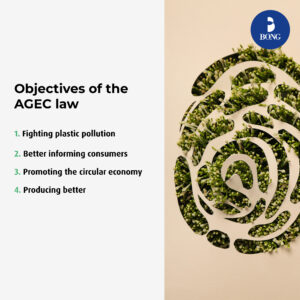
The main objectives pursued by the AGEC law are:
-
- Fighting plastic pollution: eliminate single-use plastics by 2040 and promote the use of more environmentally friendly and easily recyclable materials.
- Better informing consumers: facilitate sorting through the printing of a unique logo, the info-tri, on all packaging placed on the market.
- Promoting the circular economy: encourage reuse, repurposing, recycling, and material recovery by rethinking production, consumption, and waste management methods.
- Producing better: improve waste management by strengthening producer responsibility, creating “polluter-pays” schemes, and encouraging the implementation of innovative solutions to reduce the amount of waste produced.
AGEC law & packaging: 8 key measures to choose the right packaging
What does this mean concretely for packaging companies and the brands that use them? Let’s take a look at the key measures to remember from the AGEC law and the actions taken by Bong, a manufacturer of lightweight packaging, to improve production and assist you in choosing your packaging.
Fighting plastic pollution
According to the 2023 report published by the Cour des Comptes, “Plastic is currently at the heart of several environmental issues due to the resources consumed in its production and the amount of waste generated by its short usage duration compared to its long degradation time in the natural environment. Its harmful consequences on the carbon footprint, health, and biodiversity are now well known.”
1. Eliminate single-use plastic by 2040
The AGEC law bans the marketing of certain single-use plastic products by 2040. This applies in particular to plastic packaging that cannot be recycled or is difficult to recycle. From 2025, packaging made from oxodegradable plastic will be banned, as will packaging made from non-recyclable styrene polymers or copolymers, such as polystyrene.
2. Promote recyclable materials like paper
Although not all types of plastic are concerned, the AGEC law encourages manufacturers and brands to avoid single-use plastic packaging and to favour materials that can be reused (glass, steel, textiles) or easily recycled, such as paper or cardboard.
To reduce plastic packaging and encourage recycling, targets for 2025 have been set by decree:
- Reduce single-use packaging by 20%.
- Put an end to non-recyclable plastic packaging
- Develop prefabricated packaging made from recycled plastic.
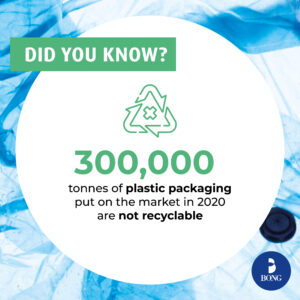
At Bong, for every plastic shipping solution, we offer paper alternatives that are both durable, protective, and fully recyclable. For example, we launched AirPro Green, an air bubble mailer designed for e-commerce shipments, made entirely of paper and air, which protects your product and is fully recyclable. For your in-store sales, Bong offers standard paper bags that can be delivered quickly or customized to meet your needs.
Better informing consumers
It is the responsibility of producers and brands to help consumers understand recycling rules, which, admittedly, are not always straightforward. The AGEC law offers a series of measures to make sorting easier and provide better information to consumers about the right thing to do when it comes to sorting their waste. It provides a framework for environmental labels on packaging to ensure they are reliable and not misleading.
3. Mandatory printing of sorting information on your packaging
From 1 January 2022, the AGEC law requires a single logo, called Info-Tri, to be printed on all household packaging placed on the French market that can be recycled. Together with the Triman logo, the info-tri logo indicates the sorting rules for each component of the packaging. The aim of this new marking is to indicate to consumers the appropriate sorting bin or container for recycling the packaging.
According to article L54-9-3 of the French Environment Code, incorporated into the AGEC law: “If several elements of the product (…) are subject to different sorting procedures, these procedures shall be detailed element by element. This information appears on the product, its packaging or, failing that, in the other documents supplied with the product”.
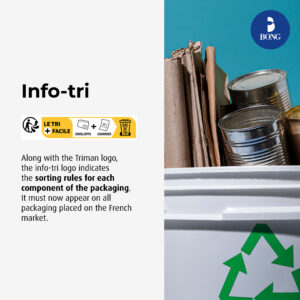
4. Manufacturers are required to provide environmental characteristics of their products
Another key measure of the AGEC law is that manufacturers and/or brands are required to provide consumers with the environmental characteristics of the packaging they place on the market. This measure aims to increase transparency and traceability of products throughout their lifecycle, from the choice of raw materials to recycling. Manufacturers must provide information on the following criteria:
- compostability
- percentage of recycled material
- reusability
- recyclability
- the presence of potential hazardous substances
- any bonuses or penalties applied to the marketed product.
The AGEC law also prohibits the use of misleading terms such as “biodegradable,” “environmentally friendly,” or similar claims on packaging. For more information, refer to the guide published by Citeo on responsible communication.
Promoting the circular economy
5. Encourage brands to move towards eco-design
The AGEC Act aims to promote a circular economy, in which resources are used more efficiently and waste is reduced to a minimum. In particular, this means rethinking production methods to limit the consumption of raw materials, provide for the reuse of products and facilitate their recycling.
This transition to the circular economy can be achieved through:
- Sustainable sourcing: considering the environmental and social impacts of the resources used, in particular those associated with their extraction and exploitation.
- Eco-design: incorporating environmental impacts throughout a product’s entire life cycle and integrating them into the design process.
- Responsible consumption: taking into account the environmental and social impacts at all stages of a product’s life cycle when making purchasing choices, whether the buyer is public or private.
- Improving waste prevention, management and recycling, including reinjecting and reusing waste materials in the economic cycle.
What is eco-design?
“Ecodesign takes into account the negative environmental impacts of a product from its conception and throughout its lifecycle, aiming to reduce them while striving to preserve its qualities and performance. It leads, in particular, to reducing the amount of material used, extending the product’s lifespan, and facilitating repair or recycling. Beyond this environmental goal, eco-design encourages innovation.” – ADEME
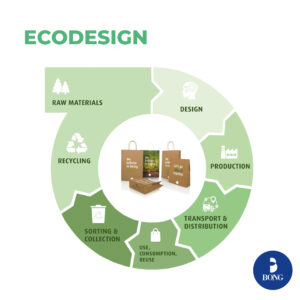
At Bong, we integrate eco-design practices by taking into account the entire life cycle of the product, from the sourcing of raw materials to recycling. We optimise the use of resources (paper, electricity, water, etc.), minimise waste and facilitate the recycling of our packaging solutions to promote more responsible consumption.
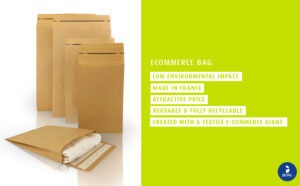
We recently launched a new e-Smart range, a low environmental impact, reusable e-commerce bag designed in partnership with a global e-commerce player. We have re-invented our production process to reduce paper consumption to 2% (compared with the usual 8%), energy consumption and waste production.
Like our e-Green bag, our e-Smart bag is designed to be reusable, thanks to a double adhesive strip that allows the end consumer to reuse the bag in the event of a product return.
6. Apply a bonus-malus system to encourage eco-design and the production of low environmental impact products
Manufacturers adopting eco-design practices will benefit from a financial advantage on their contribution to their eco-organisation. Those who fail to do so will be subject to penalties. The aim of this measure? To provide a financial incentive for manufacturers to rethink their design processes, right from the choice of raw materials.
Producing better
While consumers are being urged to be careful about what they buy and to produce less waste at their own level, this cannot be done without the support of manufacturers and brands. This need is summed up very well in the March 2023 report by the Cour des Comptes:
” As the best waste is the one that is not produced, consumers are encouraged to prioritize in their purchases goods that are more durable, produce less bulky waste, and are more easily recyclable. Consumers can only act in this direction if the industry introduces products that benefit from both ecodesign efforts and reliable, understandable labeling.” – Excerpt from the public annual report 2023 of the Cour des Comptes, published in March 2023.
7. Strengthen Extended Producer Responsibility (EPR) with the creation of new polluter-pays schemes
The aim of this measure is to expand the responsibility of manufacturers and industries in managing their waste by creating new polluter-pays schemes. Specifically, this means that manufacturers and distributors are required to set up systems for collecting, sorting, recycling and recovering the waste generated by their products, with the aim of reducing their impact on the environment.
The creation of a system for industrial and commercial packaging is scheduled for 1 January 2025.
8. Require polluter-pays schemes to create 5-year eco-design plans for their products
Producers subject to extended producer responsibility (EPR) schemes will have to draw up an action plan every five years to prevent pollution and incorporate eco-design practices into their products. These plans will aim to increase the use of recycled materials and the recyclability of products. They will be periodically reviewed. Producers will be responsible for drawing up these plans and must submit them to the relevant eco-organisation.
For further reading: Decoding the PPWR
The AGEC law has played a decisive role in accelerating the change in our production and consumption model. Bong is aware of its role as a manufacturer of lightweight packaging and is supporting its customers in this transition towards the use of solutions with a low environmental impact. While France is continuing to work towards the objectives announced in the AGEC law, the European Union has more recently decided to vote in favour of the Packaging & Packaging Waste Regulation (PPWR), which we decode for you in this other article:

